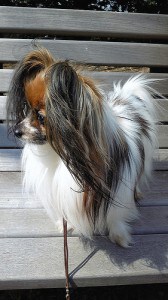From the desk of Sharda Baker.
Hi and Welcome Everyone!
This is Sharda with another Papillon newsletter!
Here is your guide to Papillon dog standards you can use to make your pet in dog show form!
Let’s start!
GENERAL APPEARANCE
- The Papillon is a small, elegant, friendly toy dog with a very fine bone structure.
- It should be a dainty size, light and full of action and affection and also healthy and strong looking.
- The Papillon’s fringed butterfly ears will distinguish it from other breeds.
SIZE, PROPORTION, SUBSTANCE
- The height of the Papillon should be eight to 11 inches (20 cm to 28 cm) at the withers.
- The body should appear slightly longer than height at the withers.
- The Papillon should not be over eleven inches high or it is considered a fault.
- If the dog is over twelve inches high then it will be disqualified.
- The Papillon’s weight should be seven to eight pounds when fully grown.
- They should be of fine boned structure.
APPEARANCE
- Papillon’s coats are long, abundant, straight, very fine and silky and flowing with a resilient quality.
- The hair on the body should be flat on both sides and the back of the Papillon’s body but with a profuse fill on its chest.
- They do not have an undercoat, and the hair on their skull should be close and short.
- The muzzle, front of forelegs and from the hocks to the hind feet should have hair that is close and short.
- Feathers, soft fine hairs, cover the backs of the Papillon’s forelegs and gradually fade out to the feet.
- The hocks of the hind legs of the Papillon are covered with abundant soft hair – called breeches.
- The tail has flowing, long plumes of hair.
- The hair on their feet is short and the pads are small.
- Papillons are white or parti-colored with patches of any colour marking except liver.
- There are also tri-coloured Papillion.
- They should be a balanced, dainty little toy dog with an attractive head, a lively and intelligent expression and an alert bearing.
- When Papillons move they should be light and free, and should not appear restricted or cramped in any way.
EYES AND EARS
- The Papillon should have dark, round eyes that are medium sized, alert and not bulging.
- The rim of the eyes is black.
- The ears should be large, with rounded tips that are set on the sides near the back of the head.
- Erect ears move like the wings of a butterfly, and carried obliquely at approximately 45 degrees to the head.
- The drop ears (also known as Phalene) are carried drooping and they must be completely down.
- Small pointed ears set too high, one ear up or ears that are partly down are considered ‘faults’.
- The ears are well fringed and inside the ear it’s covered with medium length silken hair.
HEAD
- The skull should be of medium width and rounded slightly between the ears.
- There is a well-defined stop formed where the skull and muzzle meet.
- The muzzle is about one-third the length of the head measuring from the eye to the tip of the nose.
- The Papillon’s nose is black, rounded, small and a little flat on the top.
- If the nose is not black it will be severely penalized as a fault.
- The lips are thin, tight and black with the tongue invisible when the jaws are closed.
- If the bite is overshot or undershot it will be considered a fault.
- The muzzle, front of forelegs and from the hocks to the hind feet should have hair that is close and short.
- The ears are well fringed and inside the ear it’s covered with medium length silken hair
NECK AND BODY
- The Neck should be medium length and the backline level and straight.
- The chest of the Papillon is of medium depth and the ribs are well spread.
- The Papillon’s shoulders should be laid back, which allows freedom of movement.
- Removal of the dewclaws is optional.
- The front feet are rabbit-like and should point neither in nor out.
HINDQUARTERS
- The hindquarter of a Papillon should be well angulated and developed.
- The legs are slender, parallel when viewed from behind and fine boned.
- The dewclaws on the hind legs must be removed if there are any.
- The hind feet are elongated and thin, and point neither in nor out.
- The legs should have significant breeches to add to the feathery and light appearance of the Papillon.
OTHER CHARACTERISTICS
- While a small dog, the Papillon should still appear athletic and active.
- They should be alert and attentive while in the ring, and neither timid nor aggressive while being shown.
There are Breed Standards For:
- AKC Breed Standard (American Kennel Club)
- CKC Breed Standard (Canadian Kennel Club)
- >FCI Breed Standard
- The Kennel Club (U.K) Breed Standard
- UKC Breed Standard (United Kennel Club)
That’s it for today.
Hope you learned something.
I’ll be back for more about Papillons.
Until then!
All the best and take care.
Warmly,
Sharda Baker

